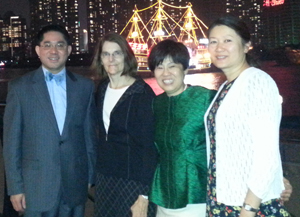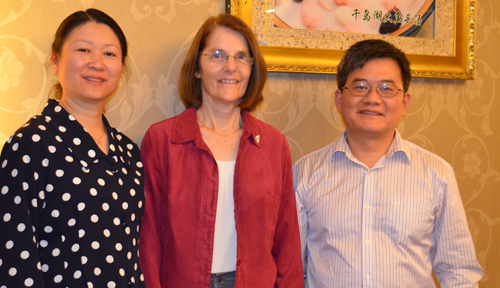SHANGHAI – Quan Dong Nguyen, M.D., is pumped.
The new chairman of ophthalmology and visual sciences, part of the UNMC delegation in China, is excited about the research that UNMC is doing with Tongji University and Tenth People's Hospital in Shanghai.
The work, led by Carol Toris, Ph.D., professor of ophthalmology and visual sciences, is aimed at improving our understanding of glaucoma, the leading cause of irreversible blindness in the United States and worldwide. More than 60 million people in the world are living with glaucoma. It's estimated that more than 80 million people will develop glaucoma by 2020.
 |
| From left, UNMC's Quan Dong Nguyen, M.D., UNMC's Carol Toris, Ph.D., Fang Wang, M.D., chair of the department of ophthalmology at Tenth People's Hospital, and UNMC's Shan Fan, M.D. |
"It's all about aqueous humor dynamics," Dr. Nguyen said. Glaucoma can occur when the optic nerve is damaged, and frequently this is associated with high intraocular pressure.
That's where aqueous humor dynamics come into play. To maintain intraocular pressure at a steady level requires a fine balance between the production, circulation and drainage of ocular aqueous humor.
Dr. Toris is one of the leading experts in the world on aqueous humor dynamics — Google the term and Dr. Toris' name is the first to appear.
Working with Tongji University and Tenth People's Hospital researchers led by Tao Guo, M.D., Dr. Toris, along with Shan Fan, M.D., assistant professor of ophthalmology and visual sciences and also with UNMC's delegation to Shanghai, measure fluid flow in the eyes of volunteers.
They have studied healthy Caucasian adults, an ethnic group that is prone to a certain type of glaucoma. Now in collaboration with Tenth People's Hospital they are studying healthy Chinese adults, an ethnic group that is prone to a different kind of glaucoma.
The team will compare data to identify differences that may help explain why people may get a particular kind of glaucoma. These findings should help determine the best treatments for the particular type of glaucoma.
"With a population of 1.35 billion, China is a fertile environment for finding research subjects," Dr. Nguyen said.
"It's a great collaboration," Dr. Nguyen proclaimed. "To have all these patients done on Chinese soil is indicative of how well the project is going."
In the next two years, Dr. Nguyen said that the Truhlsen Eye Institute at UNMC, and Tongji University and Tenth People's Hospital hope to combine forces on several other projects, expanding to other areas of significant concerns for visual loss such as age-related macular degeneration, diabetic retinopathy, and uveitis and ocular inflammation.

What a great recognition for Dr Toris and all the research being done at the Truhlsen Eye Institute! You make us proud!
Wonderful article Dr. Toris. How exciting!